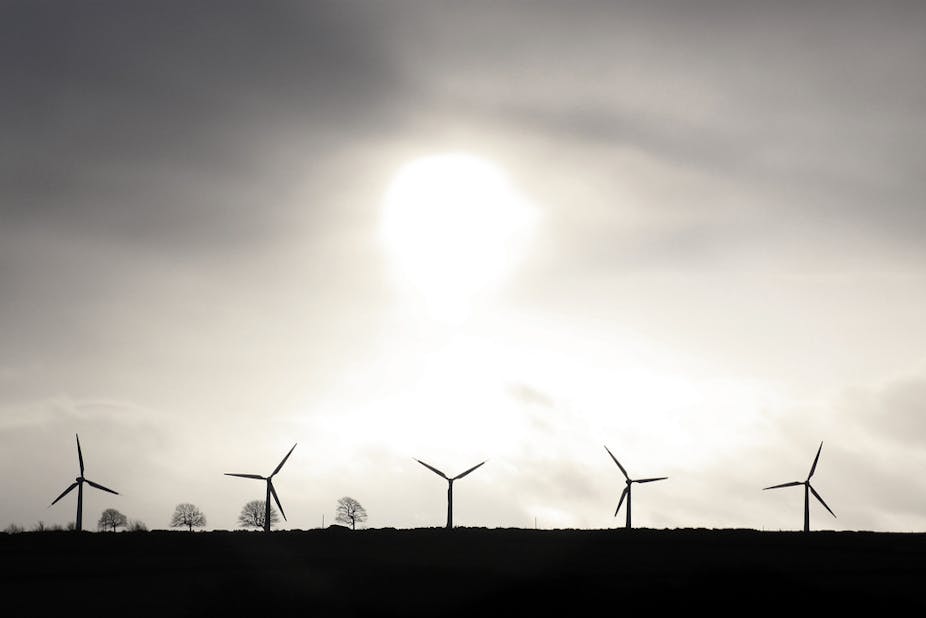Last week, Griffith University’s Vlado Vivoda argued that renewable energy “makes no economic or political sense” for Australia.
While we welcome Vivoda’s contribution to the national energy policy debate, the conclusions he draws fail to account for the clear imperatives for quickening the pace of renewable energy deployment.
First and foremost of these imperatives is climate change. Given the prominence of climate change in the political sphere, and the fact that it is a key rationale for advancing renewable energy technologies, it is puzzling that Vivoda discusses Australia’s energy future without acknowledging the implications of climate change.
The bulk of Australia’s carbon emissions are produced by the stationary energy sector. To address climate change, this sector will have to shift from fossil fuels and embrace zero-carbon energy sources.
The Australian Climate Change Committee’s report, The Critical Decade, reveals the scale of the challenge. “If we wish to have a 75% chance of observing the 2°C guardrail,” the report states, “we can emit no more than 1000 Gt (one trillion tonnes) of CO₂ in the period from 2000 to 2050.”
The problem is that Australia has already consumed more than 30% of its per capita entitlement since 2000, and therefore has some responsibility to accelerate decarbonisation of the economy.
Although Australia is well endowed with fossil fuel resources, their continued use carries social, economic, and environmental risks.
Vivoda properly notes that “energy poor” countries such as Spain, Germany and Japan have a clear interest in reducing their dependence on imported energy.
Renewable electricity generation has allowed these countries to tap local energy resources and limit their exposure to energy price rises. This strategic trend represents a risk to Australia. As one of the world’s largest producers and exporters of energy, our biggest challenge is not energy dependence but rather what might be termed “energy export dependence”.
With climate change and energy security driving the large-scale deployment of renewable technologies, what will Australia export if no one wants to buy coal anymore?
How will the Australian economy fare when the massive export revenue currently generated by coal declines?
Australia will need new export industries to fill the gap. Projected by The Pew Charitable Trust to be worth between $1.7 and $2.3 trillion over the next decade, the global renewable energy market presents a huge opportunity. Measures that develop domestic renewable energy manufacturing and expertise are in the national interest.
This was the Prime Minister’s reason for looking to Spain where well-designed feed-in tariffs (FiTs) are rapidly increasing concentrating solar thermal generating capacity.
Not only that, but the Spanish have built and are now operating the innovative Gemasolar solar “power tower” that uses molten salt energy storage technology to generate electricity 24-hours a day.
Concentrated solar thermal now feeds more than 700 MW of renewable electricity to the Spanish grid. Tariffs have facilitated enough private investment to install 2500MW by 2013, with the Spanish solar thermal industry projecting to have 10,000MW operational by 2020.
Feed-in tariffs have been similarly successful in Germany, Europe’s fastest growing major economy, where the measure has resulted in the sustained expansion of photovoltaic electricity generation. The cumulative installed capacity of photovoltaics in Germany increased from 2900MW in 2006 to over 17000MW in 2010.
There are differences between Spain, Germany and Australia that should be acknowledged.
Unlike our European friends, Australia’s solar resources are substantial, yet when it comes to solar PV Germany alone has out-installed us 10:1 on a per capita basis.
With about 200 times the per capita sunshine of the United Kingdom, and massive wind and geothermal resources, Australia has a bigger slice of the renewable resource pie than just about any other developed country.
We have a competitive advantage, should we choose to use it.
Decisions about renewable energy happen in the political arena. Vivoda presents cost of living impacts as a barrier to renewable energy policies.
According to the government’s chief climate change advisor Ross Garnaut, “Australian households and businesses enjoyed relatively stable and low retail electricity prices for many decades.
"Despite recent increases, he adds, "they continue to enjoy relatively low prices by international standards.”
Although Australians enjoy relatively low-cost energy, proponents of renewable energy policies must address the perception of cost of living pressures if effective efforts are to be politically feasible.
Renewable energy measures can be a political winner. CSIRO’s report Communication and climate change: What the Australian public thinks shows “most Australians… exhibit a strong preference for renewable energy.”
80% of respondents supported government action to increase renewable energy research and development.
In an EMC poll from November last year, 79% favour government support for the renewable energy sector.
If the Australian public’s strong support for renewable energy research, development and industry development is any indication, the prospects of well-designed renewable energy policy appear promising.
Renewables are coming down the cost curve faster than expected. Even industrial giant GE is predicting solar PV will reach grid parity (in the US) in three to five years’ time.
If Australia doesn’t get on board soon, we’ll miss the boat.
This article was co-authored by Leigh Ewbank (Ba. Soc Sci Environment Hons, RMIT University), Director of Communications at climate and energy think tank Beyond Zero Emissions.

